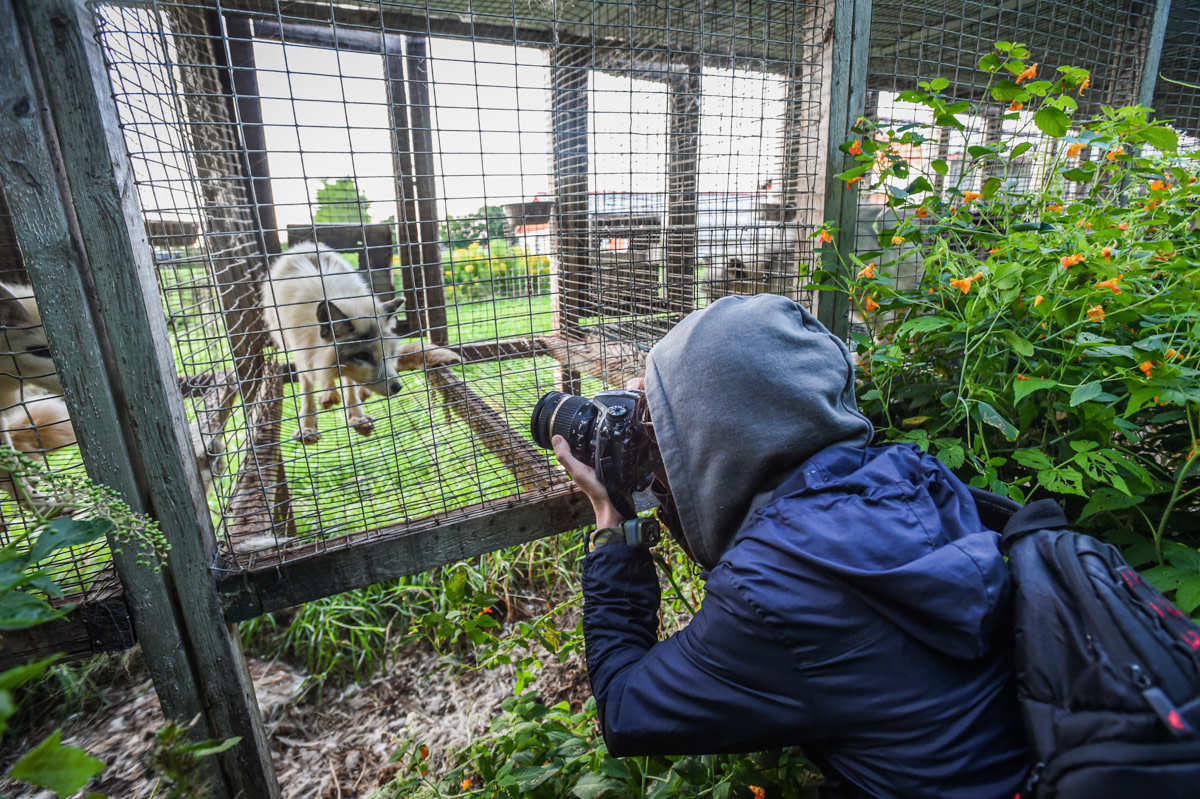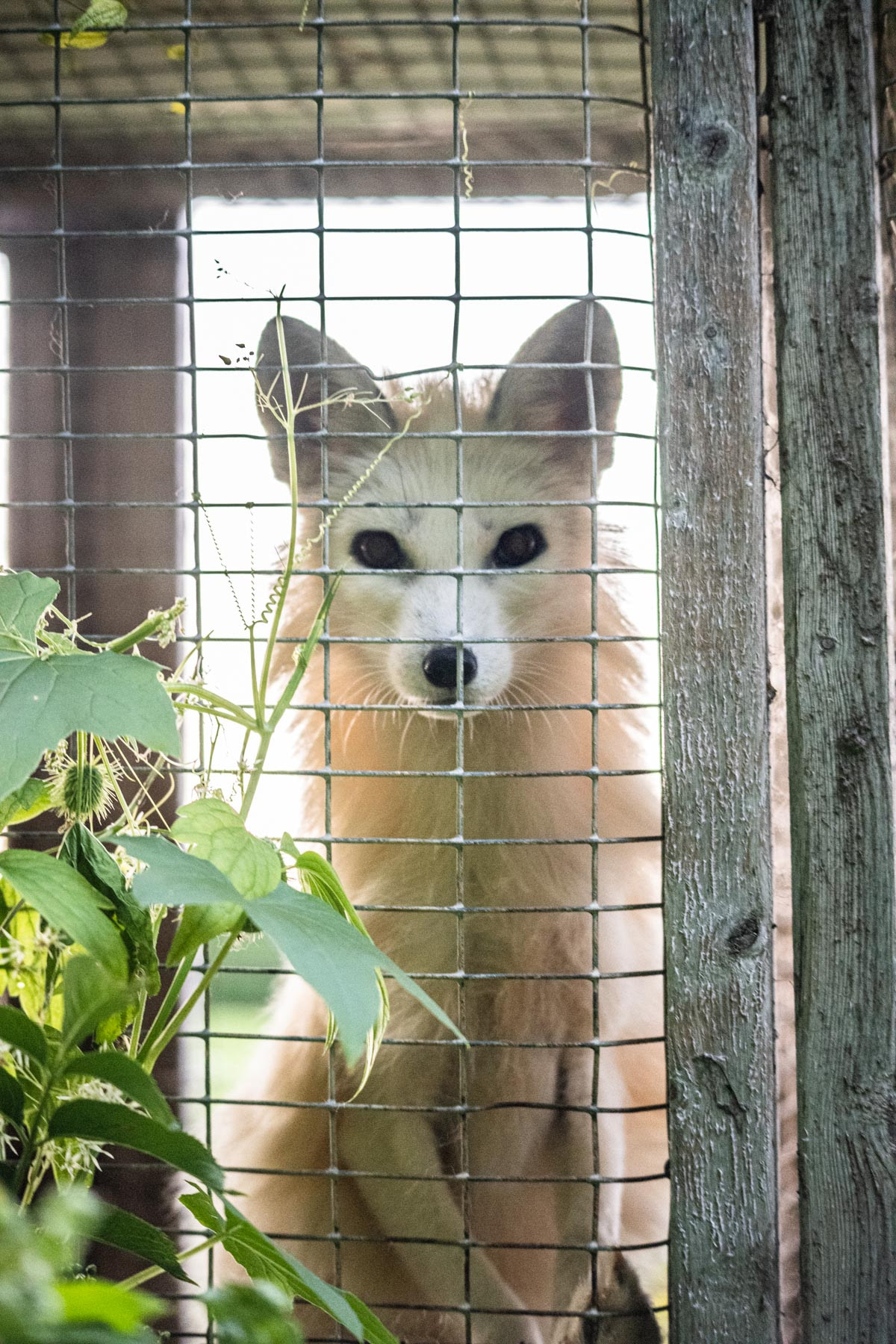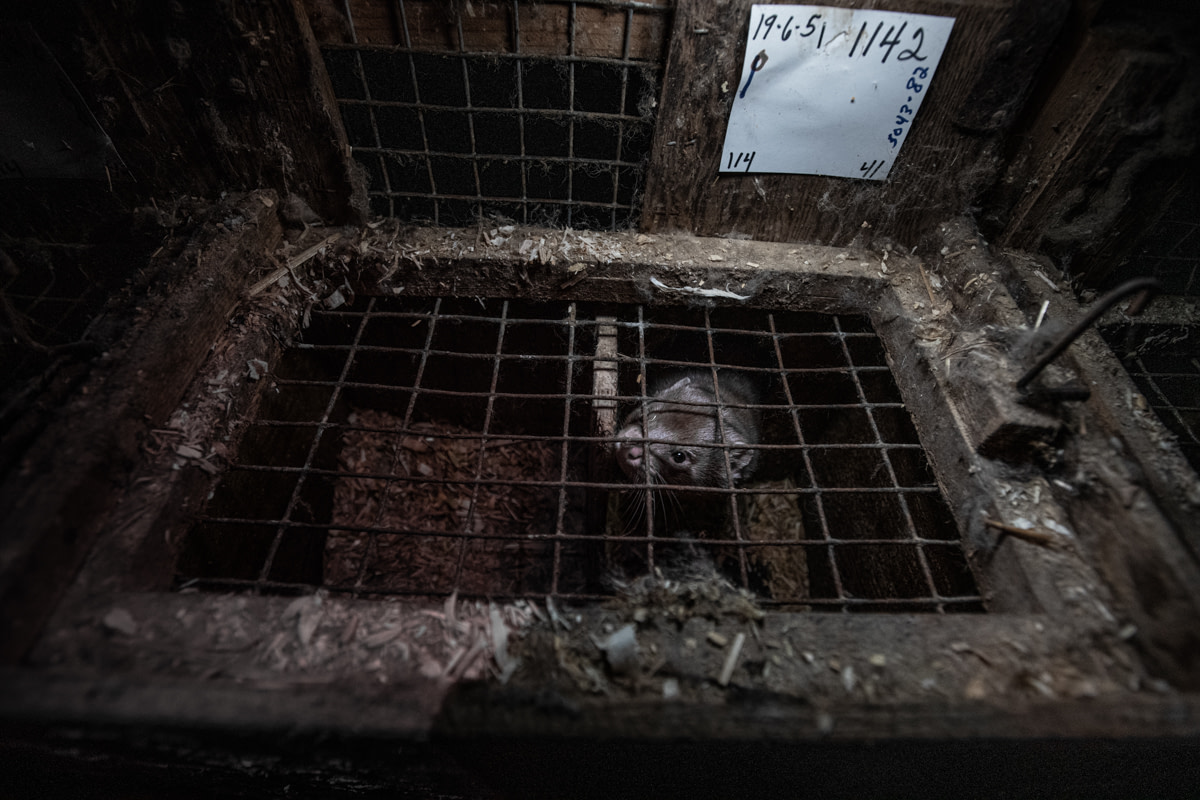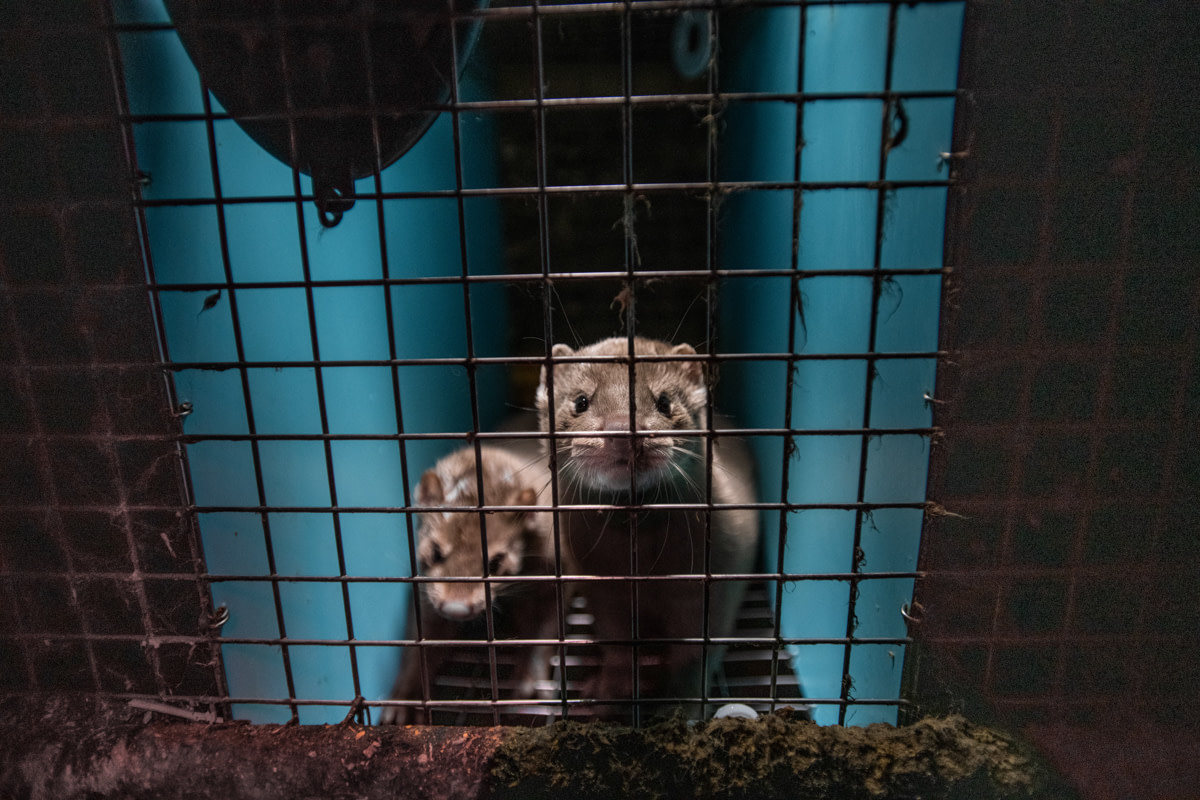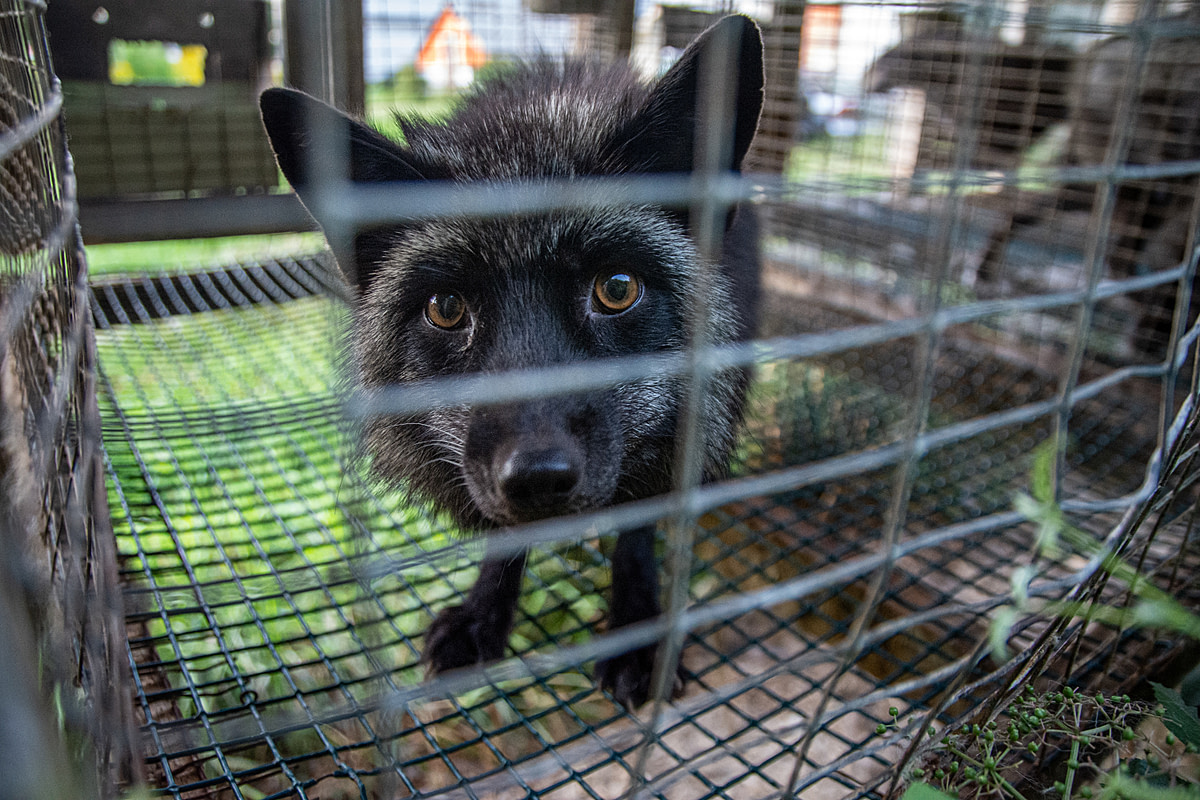A photojournalist documents a calico or marble fox dwelling inside a barren wire mesh cage at fur farm in Quebec. Canada, 2022.
We Animals
We Animals has documented horrific conditions and intense suffering for animals trapped inside two Quebec fur farms. Images taken in August show foxes living in small barren wire cages and minks confined in filthy, crowded conditions.
Photographers: We Animals, Balvik C.
The Canadian animal law advocacy organization Animal Justice believes these conditions are illegal and have filed a legal complaint with authorities. Now, Animal Justice is calling on the Quebec government to outlaw fur farming.
A farmed fox peers through the wire mesh of their barren cage at a fur farm in Quebec, Canada. This calico or marble-coated fox will spend their entire life confined, and typically alone, inside this type of cage. Foxes like this individual are used for breeding or will eventually be killed for their fur. Canada, 2022.
We Animals
In 2022, an estimated 60 mink farms remain in Canada, mostly in the eastern provinces, and approximately 35 fox farms remain in six of the country’s provinces. Canada still produces over one million minks and around 5,000 foxes each year.
The number of fox and mink farms in the province of Quebec are dwindling, with farms visibly downsizing in space and numbers. This decline of the industry in Quebec reflects national and global trends. There were over 300 fur farms in Canada in 2011, but fewer than 100 fur farms in 2021—the lowest number of farms on record. In November 2021, British Columbia became the most recent Canadian province to phase out its mink fur farming industry.

A farmed fox stares into the camera from inside their barren wire mesh cage at a fur farm in Quebec. In the neighbouring enclosure, another fox lies curled up atop the bare wire floor of their cage. These calico or marble-coated foxes spend their entire lives inside these types of cages. They are used for breeding or will eventually themselves be killed for their fur. Canada, 2022.
We Animals
“Cramming foxes and minks into barren wire cages for their entire lives deprives them of the ability to fulfill nearly every biological need. Quebec should follow in BC’s footsteps and ban this antiquated industry that causes immense suffering to animals and exposes people to dangerous public health risks.” ― Alanna Devine, Montreal-based jurist and spokesperson for Animal Justice
Farmed minks are kept in small cages. They can turn around but cannot always stand up to stretch. Pregnant minks are kept in cages with a wooden nesting box. When they give birth, the conditions become cramped as the animals grow quickly. As minks are naturally solitary animals, the stress of unnaturally close confinement causes them to fight, injure and sometimes cannibalize one another. Those who survive these conditions are killed by gassing and then skinned for use in the fashion industry for coats, trim and trinkets. Semi-aquatic animals who are highly physiologically evolved, minks are prone to hypoxia and can suffer significantly during gassing.
Small mink cages covered in a buildup of cobwebs, dirt, and dust at a fur farm in Quebec. Canada, 2022.
We Animals
“I visited this same mink farm in 2014. We now know that the farm has drastically reduced its operations, with only a few mink sheds still in use. This trend is in keeping with the decline of this dying industry.” ― Jo-Anne McArthur, animal photojournalist and Founder of We Animals
As standard industry practice, farmed foxes are kept in small cages from birth until the time they are killed by anal electrocution, which the fur industry states takes up to 10 seconds. Foxes can turn around in their cages and sometimes have a small nesting box. Some of the cages are in long sheds, while others are exposed to the elements 365 days a year in an open-sided cage with a roof. Most cages have only wire mesh for a floor. Farmed foxes live in confinement, alone or with another fox, until they are killed for use in the fashion industry.
A calico or marble fox sits alone at the back of a barren cage at a fur farm in Quebec. This fox will spend their entire life confined, and typically alone, inside this type of cage. Foxes like this individual are used for breeding or will eventually be killed for their fur. Canada, 2022.
We Animals
Two farmed foxes stand atop the wire of their barren wire mesh cage at a fur farm in Quebec. These calico or marble-coated foxes spend their entire lives, separated and typically alone, inside these types of cages. They are used for breeding or will eventually themselves be killed for their fur. Canada, 2022.
Balvik C. / We Animals
A silver fox stares through the wire from inside a barren cage at a fur farm in Quebec. Farmed foxes will spend their entire life confined, and typically alone, inside this type of cage. Foxes like this individual are used for breeding or will eventually be killed for their fur. Canada, 2022.
Balvik C. / We Animals
Over time our photojournalists have documented both foxes and minks exhibiting repetitive stress behaviours such as rapid circling and pacing, bleeding gums due to bar-biting, and muscle wasting. Eye infections are also common.
Fur farming not only causes suffering to animals. Runoff from these farms can cause blue-green algae to bloom in nearby waterways, polluting them irreparably and sickening other wildlife and humans. The risk of fur farming to public health is also of growing concern. Throughout the COVID-19 pandemic, there were numerous outbreaks on fur farms in North America and Europe, endangering farm workers and the general public due to the risk of the virus mutating. As a result, many countries culled farmed minks. By the end of 2020, Denmark became a mass grave to an estimated 17 million minks.
In recent years we’ve seen a major shift towards fur-free fashion and criticism of this industry. Just this month Jo-Anne McArthur was awarded Highly Commended in Wildlife Photographer of the Year (WPY) for depicting the harsh reality of fur farming in Sweden.
Life and Death in Fur Farming. These American mink kits fight for space and to reach their food. A sign indicates two have died. Though the legal cage size is now larger and a two-storey box a requirement for adult mink, with no more than two adults per cage, injuries still occur. WPY offers this image of ten, now eight, mink kits and their mother in a cramped nesting box, bringing the reality of fur farming under additional global scrutiny. Sweden, 2010.
Jo-Anne McArthur / Djurrattsalliansen / We Animals
“The first time I visited fur farms was in 2009. It was a shock to see the decrepit, putrid, mass incarceration of so many animals in tiny cages in rows of long sheds, offering me yet another of the many moments of disbelief that I experience in my career. I have since photographed fur farming extensively, and it is with urgency that I wish for this unnecessary industry to end.” ― Jo-Anne McArthur
An increasing number of fashion brands, cities and states are banning fur. Sixteen European countries have banned fur farming and British Columbia is permanently banning mink farming in 2023. Quebec can likewise be part of this progress.












“For every reason, fur farming is an abomination. As a photojournalist, I have seen these animals. Many are despondent while others exhibit repetitive stress behaviours. Tiny, squalid cages are no places for these animals. I implore everyone to bear witness with me. To look at these images and not turn away, and to think critically about our use of these animals. There can be no fur trade if there is no demand.” ― Jo-Anne McArthur
Take Action
In addition to their legal complaint, Animal Justice has started a petition to ask the Quebec government to outlaw fur farming. Sign the petition and support this fur ban.
Data sources: The Fur Bearers / BC Gov News / Fur Free Alliance / NBC News
Photographers: We Animals, Balvik C.
Make fur history in Quebec. Explore and download these visuals and help share these stories.

